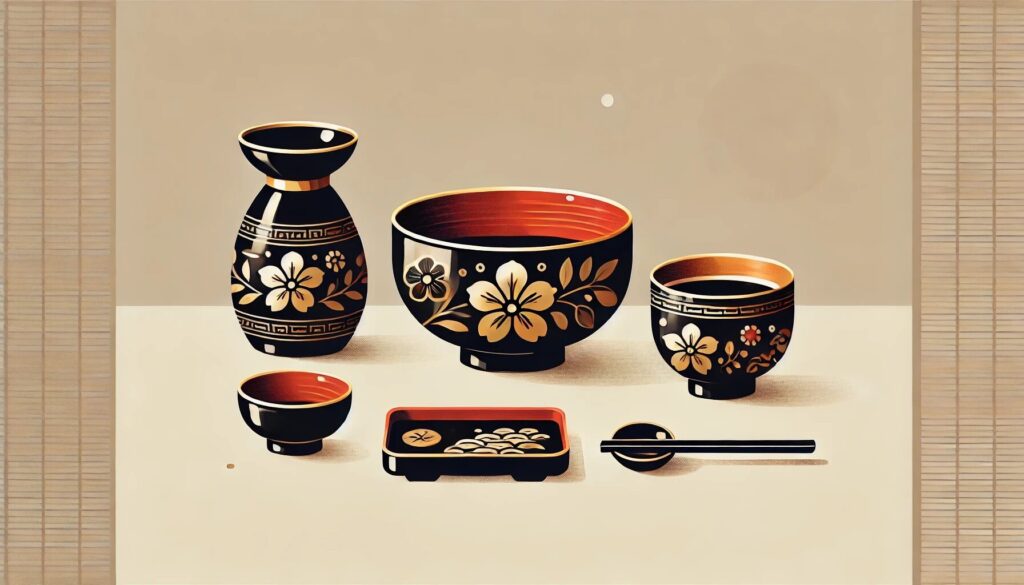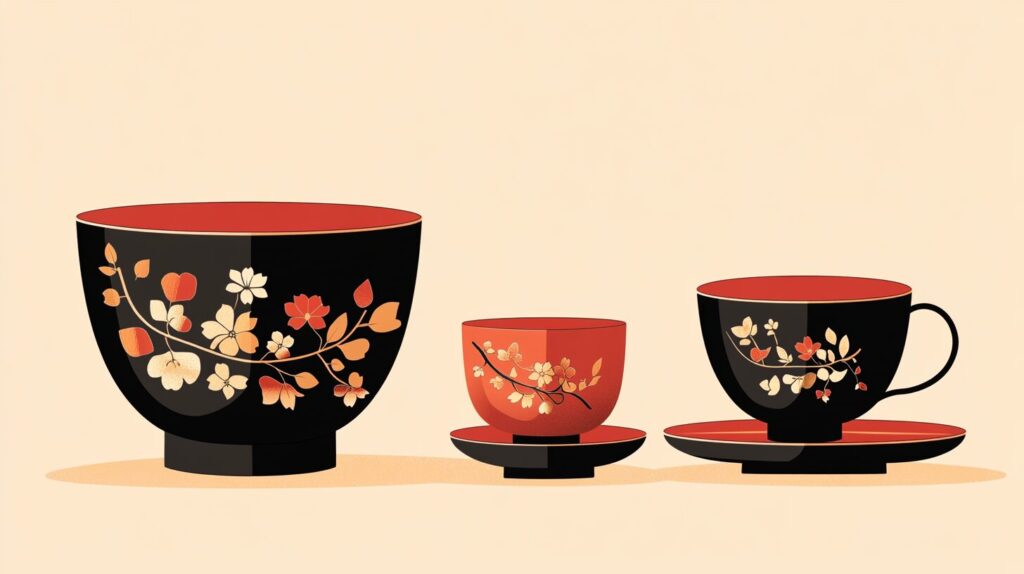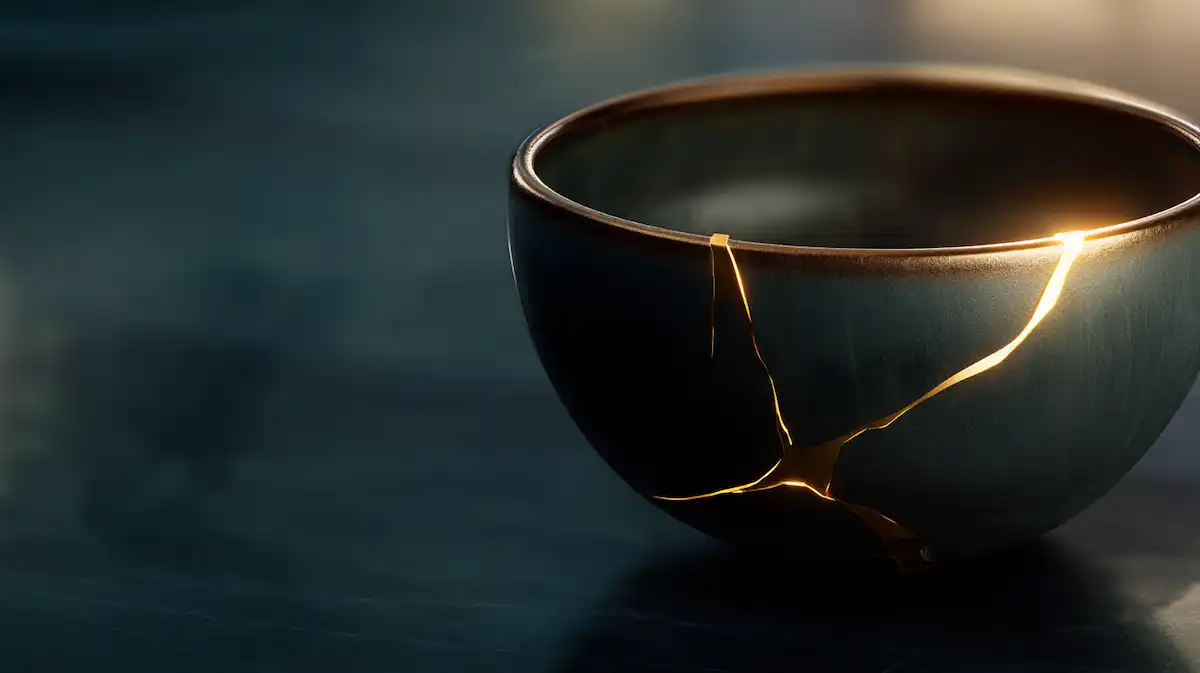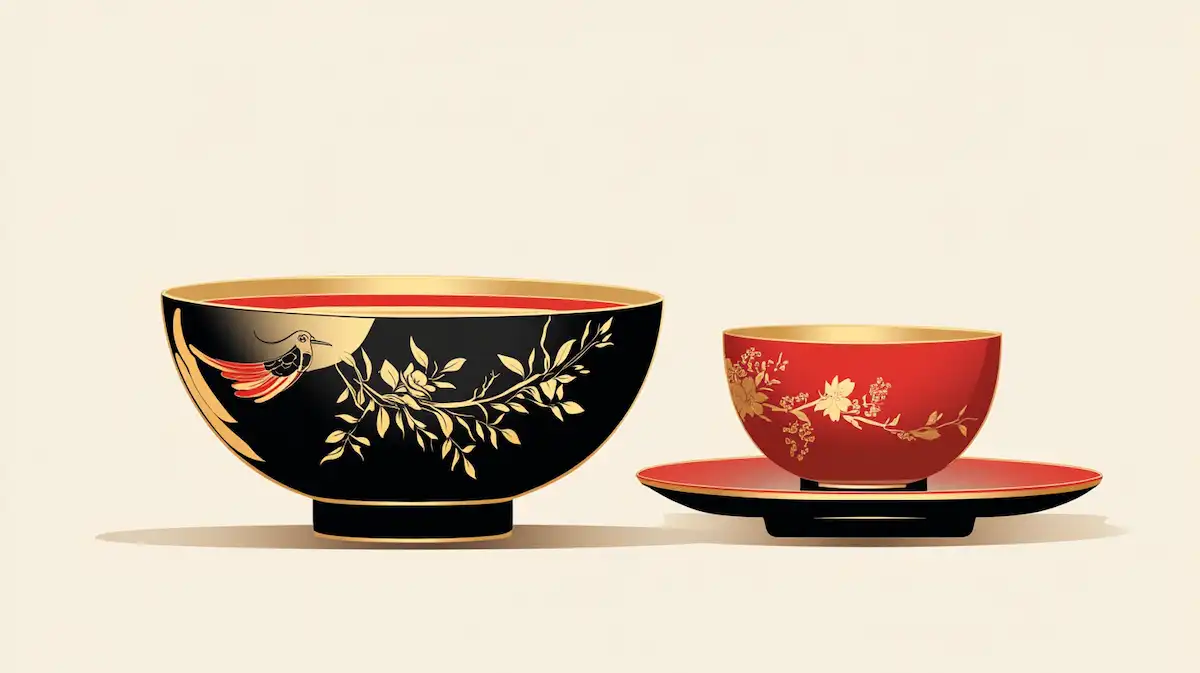漆器について英語で説明・紹介するための基本情報と、英会話に役立つ表現をシンプルでわかりやすい英語で紹介します。
英会話ダイアローグ・概要・10の質問を通して、漆器に関する英語表現を学びます。
英語
英会話ダイアローグを読む前に知っておくと良い前提知識と情報です。
- 漆器とは
- 日本の伝統工芸品で、木や竹、金属などの素材に漆を塗って仕上げるもの
- 耐久性が高く、防水性や抗菌性がある ため、食器や装飾品、家具などに使われる
- 漆器の主な特徴
- 耐久性 : 割れにくく、正しく手入れすれば何十年、何百年も使える
- 防水・耐熱・抗菌性 : 水を通さず、熱や細菌にも強いため、食器として安全
- 軽い : 木製の漆器は、陶器や金属よりも軽くて扱いやすい
- 美しい光沢 : 漆を何度も塗ることで、ツヤのある仕上がりになる
- 漆器の装飾技法
- 蒔絵(まきえ):
- 漆で模様を描き、金や銀の粉を蒔きつけて加飾する技法
- 豪華で華やかな装飾が特徴です
- 螺鈿(らでん):
- 貝殻の内側の真珠層を薄く削り、漆器にはめ込む技法
- 光の当たり方によって色が変わる、神秘的な輝きが魅力
- 金継ぎ(きんつぎ):
- 割れたり欠けたりした漆器を、漆で接着し、金や銀で装飾して修復する技法
- 修復跡を隠すのではなく、新たな美として捉える考え方が特徴
- 蒔絵(まきえ):
- 現代での人気
- 日本の家庭 : 味噌汁の椀 など、今でも日常的に使われている
- 特別な行事 : お正月や贈り物 としてよく選ばれる
- 海外の人気 : 日本文化に興味がある人やアートコレクター に人気
- 有名な産地
- 産地によって、技法やデザインに違いがある
- 輪島塗(石川県):堅牢さが特徴
- 会津塗(福島県):鮮やかな色彩が特徴
- 津軽塗(青森県):独特の変わり塗りが特徴
- 山中塗(石川県):挽物技術が特徴
- 産地によって、技法やデザインに違いがある
2人が漆器について話しています。
漆器の歴史、素材や製法、蒔絵や沈金などの装飾技法、耐久性や手入れ方法、修理方法(金継ぎ)などを話題にしています。
会話 / dialogue

Hey Key, I’ve been seeing a lot of lacquerware in traditional shops recently. It looks so elegant! Do you know much about it?

Yeah, actually, I do! Lacquerware, or “shikki” , has a really deep history in Japan. It’s been around for over 9,000 years, dating back to the Jomon period.

Wow, that long? I thought it was just another type of tableware.

Nope! It’s much more than that. It’s not just tableware—it’s art, history, and craftsmanship combined. It’s been used in tea ceremonies, temples, and even exported to Europe centuries ago.

That’s amazing. So, what exactly is lacquerware made of?

It’s made by coating materials like wood, bamboo, or even metal with lacquer—a natural resin from the lacquer tree. When it dries, it creates a strong, glossy, and waterproof surface.

That explains why it looks so smooth and shiny! But is it fragile?

Not at all! Lacquerware is extremely durable. If you take care of it properly, it can last for generations.

Really? So, it won’t get damaged easily?

Well, it’s resistant to water, heat, and even bacteria, but you shouldn’t put it in a microwave or dishwasher. Hand washing is best.

That makes sense. I’ve noticed some lacquerware has gold or silver patterns on it. How do they do that?

That’s a technique called Maki-e. The craftsmen sprinkle gold or silver powder onto the lacquer to create beautiful designs. There’s also Chinkin, where they engrave patterns and fill them with gold, and Raden, which uses mother-of-pearl inlay.

Wow, so each piece is handmade and unique?

Exactly! That’s why some pieces are considered artworks, not just dishes. Some high-quality lacquerware is very expensive because of the craftsmanship involved.

I see. But do people still use lacquerware today?

Absolutely! In Japan, many families still use lacquer bowls for miso soup, and it’s popular for New Year’s celebrations and gifts. High-end restaurants and hotels also use it to create an elegant atmosphere.

That’s cool. But what about younger people? Do they like lacquerware?

Well, not as much as before. Many young people prefer cheaper materials like plastic or ceramic. But interest is growing again because lacquerware is eco-friendly and lasts a long time.

That’s good to hear! Speaking of lasting a long time, what if lacquerware breaks? Is it repairable?

Yes! There’s a traditional technique called Kintsugi—it means “golden repair.” They fix broken lacquerware by filling the cracks with gold or silver lacquer. It makes the item even more beautiful and tells a story of its past.

That’s incredible! Instead of throwing things away, they turn damage into art.

Exactly! It’s part of the Japanese philosophy of wabi-sabi, which sees beauty in imperfections.

I love that idea. I think I’ll buy some lacquerware for myself. Do you know any good places?

Definitely! You should check out Wajima lacquerware from Ishikawa or Aizu lacquerware from Fukushima. There are also some great lacquerware shops in Asakusa and Kyoto.

Thanks, Key! I had no idea lacquerware had so much history and meaning behind it.

No problem! It’s more than just plates and bowls—it’s a piece of Japanese tradition. Let me know if you want to go shopping together!

Sounds great! I’d love that.
概要 / Overview
「漆器」について、理解を深めるための「英語での概要」です。
漆器

What is Lacquerware?
Lacquerware is a beautiful traditional craft from Japan. It is made by covering materials like wood, bamboo, or metal with lacquer. Lacquer is a natural resin (a kind of liquid) that comes from a special tree called the lacquer tree. When lacquer dries, it makes a smooth, shiny, and very strong surface. It has been used in Japan for more than 9,000 years.
How is Lacquerware Made?
Making lacquerware takes a lot of skill and time. First, craftsmen shape wood or bamboo into bowls, plates, or boxes. Next, they paint the objects carefully with lacquer. They apply many coats, one after another. Each coat must dry completely before the next one is added. Sometimes, special techniques are used to decorate the lacquerware with beautiful patterns. These patterns often include gold powder, silver powder, or shells.
Special Features of Lacquerware
One of the best things about lacquerware is its durability. If you take care of it, lacquerware can last for a very long time—sometimes for hundreds of years! It is waterproof, heat-resistant, and naturally antibacterial. This makes lacquerware safe and practical for daily use. It is also lightweight, so it is easy to handle.
Why People Love Lacquerware
Many people love lacquerware because of its elegance and beauty. It has a unique shine and smooth feel. Over time, lacquerware becomes even more attractive as it ages. Another great thing is that if lacquerware breaks, it can be repaired using a traditional method called “Kintsugi.” This method fixes broken pieces with gold, making the item even more special. Today, lacquerware is popular as gifts, souvenirs, and decorative items, and it represents Japanese culture around the world.
10の質問 / 10 questions
「漆器」について、理解を深めるための「英語での10の質問」です。
1: What is lacquerware?
Lacquerware is a traditional Japanese craft made by coating wood, bamboo, or metal with lacquer, a natural resin from the lacquer tree. It has been used in Japan for over 9,000 years.
2: How is lacquerware made?
It is made by applying multiple layers of lacquer to a base material. Each layer is carefully dried and polished before the next one is added. This process creates a smooth, strong, and glossy surface.
3: What are the main features of lacquerware?
Lacquerware is durable, waterproof, heat-resistant, and naturally antibacterial. It also has a beautiful shine that improves over time with use.
4: What are the different types of lacquerware decoration?
Some common techniques include maki-e (gold or silver powder decoration), chinkin (engraved patterns filled with gold), and raden (mother-of-pearl inlay).
5: Why is lacquerware expensive?
High-quality lacquerware is expensive because it requires skilled craftsmanship, natural materials, and a long production process with multiple layers of lacquer.
6: How should lacquerware be cared for?
Lacquerware should be washed by hand with mild soap and dried immediately. It should not be put in a microwave, dishwasher, or exposed to direct sunlight for long periods.
7: What is kintsugi?
Kintsugi is a traditional Japanese repair technique where broken lacquerware is fixed using gold or silver lacquer, making the cracks a beautiful part of the design.
8: Is lacquerware still used today?
Yes, lacquerware is still used in Japan for traditional dishes like miso soup bowls, in tea ceremonies, and as decorative or luxury items.
9: Where are the famous lacquerware production areas in Japan?
Some well-known lacquerware-producing regions include Wajima (Ishikawa), Aizu (Fukushima), and Yamanaka (Ishikawa).
10: Why is lacquerware considered eco-friendly?
Lacquerware is made from natural materials and lasts for a long time. Unlike plastic, it is biodegradable and can be repaired instead of thrown away.

和訳付
会話 / dialogue

Hey Key, I’ve been seeing a lot of lacquerware in traditional shops recently. It looks so elegant! Do you know much about it?
最近、伝統的なお店で漆器をよく見るんだけど、すごく上品だね!キーは漆器について詳しい?

Yeah, actually, I do! Lacquerware, or “shikki”, has a really deep history in Japan. It’s been around for over 9,000 years, dating back to the Jomon period.
実は結構知ってるよ!漆器は「shikki」って言うんだけど、日本では9000年以上の歴史があって、縄文時代まで遡るんだよ。

Wow, that long? I thought it was just another type of tableware.
えっ、そんなに昔から?ただの食器だと思ってたよ。

Nope! It’s much more than that. It’s not just tableware—it’s art, history, and craftsmanship combined. It’s been used in tea ceremonies, temples, and even exported to Europe centuries ago.
いやいや、それだけじゃないんだ。漆器は単なる食器じゃなくて、芸術や歴史、職人技が詰まってるものなんだよ。茶道やお寺でも使われてるし、何百年も前にはヨーロッパにも輸出されてたんだよ。

That’s amazing. So, what exactly is lacquerware made of?
すごいね。ところで、漆器って具体的には何でできてるの?

It’s made by coating materials like wood, bamboo, or even metal with lacquer—a natural resin from the lacquer tree. When it dries, it creates a strong, glossy, and waterproof surface.
木や竹、金属などの素材に、漆の木から取れる天然の樹脂を塗って作られてるんだ。乾くと丈夫で光沢がある防水性の表面になるんだよ。

That explains why it looks so smooth and shiny! But is it fragile?
だからあんなに滑らかで光沢があるんだね。でも、壊れやすかったりしない?

Not at all! Lacquerware is extremely durable. If you take care of it properly, it can last for generations.
全然そんなことないよ!漆器はとても丈夫だから、ちゃんとお手入れすれば何世代も使えるんだ。

Really? So, it won’t get damaged easily?
本当に?じゃあ簡単には傷つかないってこと?

Well, it’s resistant to water, heat, and even bacteria, but you shouldn’t put it in a microwave or dishwasher. Hand washing is best.
まあ、水や熱、細菌にも強いけど、電子レンジや食洗機は使わない方がいいね。手洗いがベストだよ。

That makes sense. I’ve noticed some lacquerware has gold or silver patterns on it. How do they do that?
なるほどね。金や銀の模様がある漆器も見かけるけど、あれはどうやってるの?

That’s a technique called Maki-e. The craftsmen sprinkle gold or silver powder onto the lacquer to create beautiful designs. There’s also Chinkin, where they engrave patterns and fill them with gold, and Raden, which uses mother-of-pearl inlay.
あれは蒔絵っていう技法で、職人が金や銀の粉を漆の上に振りかけて美しい模様を作るんだ。他にも、模様を彫って金で埋める「沈金」や、貝殻を使う「螺鈿」って技法もあるよ。

Wow, so each piece is handmade and unique?
へぇ、じゃあ一つひとつ手作りで、どれも一点物ってこと?

Exactly! That’s why some pieces are considered artworks, not just dishes. Some high-quality lacquerware is very expensive because of the craftsmanship involved.
その通り!だから単なる食器じゃなくて芸術品として扱われるものもある。職人技があるから、高級漆器はかなり高価になることもあるよ。

I see. But do people still use lacquerware today?
なるほど。でも、今でも漆器って使われてるの?

Absolutely! In Japan, many families still use lacquer bowls for miso soup, and it’s popular for New Year’s celebrations and gifts. High-end restaurants and hotels also use it to create an elegant atmosphere.
もちろん!日本では今でも多くの家庭が味噌汁の椀に使ってるし、お正月やギフトにも人気があるよ。高級なレストランやホテルでも使われているよ。

That’s cool. But what about younger people? Do they like lacquerware?
それはいいね。でも若い人はどう?漆器は好きなのかな?

Well, not as much as before. Many young people prefer cheaper materials like plastic or ceramic. But interest is growing again because lacquerware is eco-friendly and lasts a long time.
昔ほどではないかな。若い人はプラスチックや陶器みたいな安い素材を選ぶけど、最近はエコで長持ちするから再び注目され始めているよ。

That’s good to hear! Speaking of lasting a long time, what if lacquerware breaks? Is it repairable?
それはいいね!長持ちといえば、漆器って壊れたら修理できるの?

Yes! There’s a traditional technique called Kintsugi—it means “golden repair.” They fix broken lacquerware by filling the cracks with gold or silver lacquer. It makes the item even more beautiful and tells a story of its past.
できるよ!「金継ぎ」(ゴールデン・リペア)っていう伝統的な修理法があるんだ。壊れた部分を金や銀の漆で埋めることで、より美しくなって、その歴史も感じられるんだよ。

That’s incredible! Instead of throwing things away, they turn damage into art.
すごいな!捨てるんじゃなくて、傷を芸術に変えるなんて。

Exactly! It’s part of the Japanese philosophy of wabi-sabi, which sees beauty in imperfections.
そうそう、それは日本の「わびさび」の精神にも通じるんだよ。欠けや傷に美しさを見出す考え方だよ。

I love that idea. I think I’ll buy some lacquerware for myself. Do you know any good places?
その考え方、好きだな。俺も漆器を買おうかな。おすすめの場所ある?

Definitely! You should check out Wajima lacquerware from Ishikawa or Aizu lacquerware from Fukushima. There are also some great lacquerware shops in Asakusa and Kyoto.
もちろん!石川の輪島塗や福島の会津塗は有名だし、浅草や京都にもいいお店があるよ。

Thanks, Key! I had no idea lacquerware had so much history and meaning behind it.
ありがとうキー!漆器にこんなに深い歴史や意味があるなんて知らなかったよ。

No problem! It’s more than just plates and bowls—it’s a piece of Japanese tradition. Let me know if you want to go shopping together!
どういたしまして!ただの食器じゃなくて、日本の伝統の一部だよ。一緒に買い物行くなら言ってね!

Sounds great! I’d love that.
ぜひ!楽しみだよ。
概要 / Overview
漆器

What is Lacquerware?
Lacquerware is a beautiful traditional craft from Japan. It is made by covering materials like wood, bamboo, or metal with lacquer. Lacquer is a natural resin (a kind of liquid) that comes from a special tree called the lacquer tree. When lacquer dries, it makes a smooth, shiny, and very strong surface. It has been used in Japan for more than 9,000 years.
漆器とは?
漆器(しっき)は、日本の美しい伝統工芸品です。木や竹、金属などの素材に漆(うるし)を塗って作られます。漆は漆の木からとれる天然の樹脂(液体)で、乾くと滑らかで光沢があり、とても丈夫な表面を作ります。日本では9,000年以上前から使われています。
How is Lacquerware Made?
Making lacquerware takes a lot of skill and time. First, craftsmen shape wood or bamboo into bowls, plates, or boxes. Next, they paint the objects carefully with lacquer. They apply many coats, one after another. Each coat must dry completely before the next one is added. Sometimes, special techniques are used to decorate the lacquerware with beautiful patterns. These patterns often include gold powder, silver powder, or shells.
漆器はどのように作られる?
漆器作りには高い技術と時間が必要です。まず、職人は木や竹を削って、お椀やお皿、箱などの形にします。次に、漆を丁寧に塗ります。この工程は何度も繰り返され、一つの層が完全に乾いてから、次の層が塗られます。また、漆器には特別な装飾技法が使われることもあり、金粉や銀粉、貝殻などを使って美しい模様が描かれます。
Special Features of Lacquerware
One of the best things about lacquerware is its durability. If you take care of it, lacquerware can last for a very long time—sometimes for hundreds of years! It is waterproof, heat-resistant, and naturally antibacterial. This makes lacquerware safe and practical for daily use. It is also lightweight, so it is easy to handle.
漆器の特長
漆器の最大の魅力の一つは、その耐久性です。正しく手入れをすれば、何十年、場合によっては何百年も使うことができます。また、防水性があり、熱にも強く、自然な抗菌作用もあるため、安全で実用的な食器として人気があります。さらに、とても軽いため、扱いやすいのも大きな特長です。
Why People Love Lacquerware
Many people love lacquerware because of its elegance and beauty. It has a unique shine and smooth feel. Over time, lacquerware becomes even more attractive as it ages. Another great thing is that if lacquerware breaks, it can be repaired using a traditional method called “Kintsugi.” This method fixes broken pieces with gold, making the item even more special. Today, lacquerware is popular as gifts, souvenirs, and decorative items, and it represents Japanese culture around the world.
なぜ漆器は愛されるのか?
漆器は、その上品さと美しさから多くの人に愛されています。独特の光沢と滑らかな手触りがあり、使い込むほどにさらに美しくなるのも魅力です。また、壊れても「金継ぎ(きんつぎ)」という伝統技法で修理ができるため、さらに特別な価値を持つようになります。現在では、贈り物やお土産、インテリアとしても人気があり、日本文化を象徴する工芸品として世界中で知られています。
10の質問 / 10 questions
1: What is lacquerware?
漆器とは何ですか?
Lacquerware is a traditional Japanese craft made by coating wood, bamboo, or metal with lacquer, a natural resin from the lacquer tree. It has been used in Japan for over 9,000 years.
漆器は、木や竹、金属に漆の木から採れる天然の樹脂を塗って作られる日本の伝統工芸品です。日本では9,000年以上前から使用されています。
2: How is lacquerware made?
漆器はどのように作られますか?
It is made by applying multiple layers of lacquer to a base material. Each layer is carefully dried and polished before the next one is added. This process creates a smooth, strong, and glossy surface.
漆器は、木や竹などの素材に何層にもわたって漆を塗ることで作られます。各層は慎重に乾燥させ、研磨された後に次の層が塗られます。この工程によって滑らかで丈夫で光沢のある表面が生まれます。
3: What are the main features of lacquerware?
漆器の主な特徴は何ですか?
Lacquerware is durable, waterproof, heat-resistant, and naturally antibacterial. It also has a beautiful shine that improves over time with use.
漆器は耐久性があり、防水性や耐熱性に優れ、自然な抗菌作用もあります。また、使い込むほどに美しい光沢が増していきます。
4: What are the different types of lacquerware decoration?
漆器の装飾にはどのような種類がありますか?
Some common techniques include maki-e (gold or silver powder decoration), chinkin (engraved patterns filled with gold), and raden (mother-of-pearl inlay).
代表的な技法には、金や銀の粉で装飾する蒔絵、彫刻した模様に金を埋め込む沈金、貝殻を使って模様を施す螺鈿があります。
5: Why is lacquerware expensive?
なぜ漆器は高価なのですか?
High-quality lacquerware is expensive because it requires skilled craftsmanship, natural materials, and a long production process with multiple layers of lacquer.
高品質な漆器は、熟練した職人の技術や天然素材を必要とし、漆を何層にも塗る長い製作工程があるため高価になります。
6: How should lacquerware be cared for?
漆器はどのように手入れすればよいですか?
Lacquerware should be washed by hand with mild soap and dried immediately. It should not be put in a microwave, dishwasher, or exposed to direct sunlight for long periods.
漆器は、中性洗剤で手洗いし、すぐに乾かすのが良いです。電子レンジや食洗機の使用、長時間の直射日光への曝露は避けるべきです。
7: What is kintsugi?
金継ぎとは何ですか?
Kintsugi is a traditional Japanese repair technique where broken lacquerware is fixed using gold or silver lacquer, making the cracks a beautiful part of the design.
金継ぎは、日本の伝統的な修復技法で、割れた漆器を金や銀の漆で修理し、ひび割れを美しいデザインの一部として活かします。
8: Is lacquerware still used today?
漆器は今でも使われていますか?
Yes, lacquerware is still used in Japan for traditional dishes like miso soup bowls, in tea ceremonies, and as decorative or luxury items.
はい、漆器は今でも日本で、味噌汁椀などの伝統的な食器として使われるほか、茶道や装飾品、高級品としても利用されています。
9: Where are the famous lacquerware production areas in Japan?
日本の有名な漆器の産地はどこですか?
Some well-known lacquerware-producing regions include Wajima (Ishikawa), Aizu (Fukushima), and Yamanaka (Ishikawa).
有名な漆器の産地には、石川県の輪島、福島県の会津、石川県の山中などがあります。
10: Why is lacquerware considered eco-friendly?
なぜ漆器は環境に優しいと考えられているのですか?
Lacquerware is made from natural materials and lasts for a long time. Unlike plastic, it is biodegradable and can be repaired instead of thrown away.
漆器は天然素材から作られ、長期間使用できます。プラスチックとは違い、自然に分解され、壊れても修理できるため、環境に優しいと考えられています。

words & phrases
英会話ダイアローグと関連情報に出てきた単語・フレーズです(例文は各3つ)。

combined : 形容詞
意味: 2つ以上のものを結びつけた、組み合わされた。Made by joining two or more things together.
( 「漆器は芸術、歴史、職人技が組み合わさったもの」として使われ、単なる食器以上の価値を持つことを示す)
例文:
- Lacquerware is combined with art, history, and craftsmanship.
「漆器は芸術、歴史、職人技が組み合わさったものです。」 - The combined skills of the craftsmen make each piece unique.
「職人たちの技が組み合わさることで、それぞれの作品が唯一無二のものになります。」 - The festival was a combined effort of the whole community.
「その祭りは地域全体の共同の努力によって開催されました。」
resin : 名詞
意味: 樹脂。木や植物から分泌される粘着性のある液体で、固まると硬くなる。A sticky substance produced by trees or plants that hardens over time.
(「漆器は漆の木から採れる樹脂で作られている」として、漆器の素材の説明に使用)
例文:
- Lacquer is a natural resin from the lacquer tree.
「漆は漆の木から採れる天然の樹脂です。」 - Some artists use resin to create glossy paintings.
「一部のアーティストは樹脂を使って光沢のある絵を作ります。」 - The scientist studied the properties of the tree’s resin.
「その科学者は木の樹脂の性質を研究しました。」
glossy : 形容詞
意味: 光沢のある、つやつやした。Having a shiny and smooth surface.
(「漆器は光沢があり、時間が経つにつれてさらに輝きを増す」として、漆器の美しさを表す)
例文:
- Lacquerware has a glossy and smooth finish.
「漆器は光沢があり、滑らかな仕上がりになっています。」 - She bought a glossy magazine at the store.
「彼女は店で光沢のある雑誌を買いました。」 - The car had a glossy red paint job.
「その車は光沢のある赤い塗装が施されていました。」
fragile : 形容詞
意味: 壊れやすい、もろい。Easily broken or damaged.
(「漆器は非常に丈夫だが、電子レンジや食洗機には向かない」という説明の中で、間違った扱いをすると壊れやすいことを示す)
例文:
- Be careful! This lacquerware is fragile.
「気をつけて!この漆器は壊れやすいです。」 - The package contained fragile glassware.
「その荷物には壊れやすいガラス製品が入っていました。」 - His confidence was fragile after the failure.
「その失敗の後、彼の自信はもろくなっていた。」
durable : 形容詞
意味: 丈夫な、長持ちする。Able to last for a long time without breaking or becoming damaged.
( 「漆器は非常に丈夫で、何世代にもわたって使える」として、漆器の長寿命の特長を説明する際に使用)
例文:
- Lacquerware is extremely durable if taken care of properly.
「漆器は適切に手入れをすれば非常に丈夫です。」 - This watch is made of durable materials.
「この腕時計は耐久性のある素材で作られています。」 - Leather shoes are more durable than fabric ones.
「革靴は布製の靴よりも耐久性があります。」
詳細情報 / Further Info
関連記事(金継ぎ)

